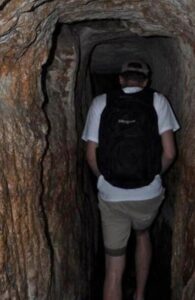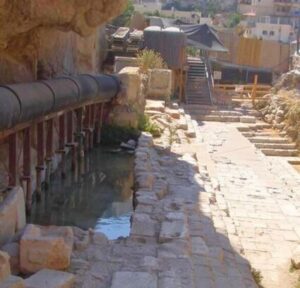Disturbing events in our day cause us to question God’s presence and purpose, but the imperative to love, as Jesus demonstrated to a blind man, continues to be clear.
GLENN M. WAGNER
Michigan Conference Communications
Spiritual fog can blur our ability to see God. It is hard to see God’s love in the middle of horrific wars like those in Ukraine and Gaza. It is difficult to discern God’s presence in situations where people we love are dealing with life-threatening medical issues. Many struggle to see God’s love in Christian communities divided over irreconcilable differences on matters of inclusion and politics.
The Bible offers us help to keep serving God even in a spiritual fog. Consider the Gospel of John’s record of Jesus’ dramatic healing of a man who was born blind (John 9:1-38).
Blind persons in Jesus’ day were cut off from full participation in the community not only by their disability but also by prevailing public attitudes that linked blindness with social stigma. There is a reason that this man is remembered in the Bible not by name but by his condition.
The questions of Jesus’ disciples about the blind man echoed common misunderstandings about God and blamed the misfortune of blindness on sin and divine punishment.
Jesus’ followers asked, “Who sinned, this man or his parents, that he was born blind?” Jesus corrected his disciples and claimed that this man’s blindness happened so that the works of God could be shown through his life, not because of sin.
Jesus then spit on some mud, packed it on the blind man’s eyes, and instructed him to wash his eyes at the Pool of Siloam. The blind man did as Jesus asked. Miraculously, he was able to see. The only explanation given for this healing is divine intervention. At the end of his Gospel, John acknowledges that Jesus performed many wonderful signs, so we may believe that Jesus is the Christ, the Son of God, and by believing, we may have eternal life in his name (John 20:30-31).
Imagine this moment of total life transformation for a man who, before he met Jesus, knew only blindness! The permanent fog dissipated. A lifetime of darkness was suddenly illuminated. Colors came bursting forth for the first time. Shapes, previously only understood by touch, were given visual definitions. A man who had never seen anything before could now clearly see that sight is a life-transforming gift for which he will forever be grateful to Jesus.
John remembers the cruel irony of the occasion. In the face of this miracle, the religious leaders of Jerusalem, who spent their lives learning God’s scriptures, completely missed the miracle of God’s action right in front of them. It is almost as if the persons best trained to discern God’s glory lived in a dense fog. For his entire life, the newly healed man had been exiled from full participation in his faith community by his disability. The miracle of his healing at the Pool of Siloam should have made headlines and been celebrated by all as an occasion of great restoration.
Instead, Jerusalem’s religious leaders did not trust the newly sighted man’s testimony. They were upset that he was healed in a violation of their understanding of the Sabbath, treated the miracle like a criminal conspiracy, and expelled the man from their fellowship at the very moment he should have been fully and joyfully restored. It is also probable that Jerusalem’s religious leaders had to juggle desires daily to keep their Roman overlords happy, secure the economic well-being of the temple, and maintain their religious authority. With his miracles, prophetic message, and popular appeal, Jesus threatened the status quo, and the religious establishment knew it.
Their response to the miracle of the blind man’s healing leaves no question about who is truly blind in this story.
Biblical history and archaeology in Jerusalem concerning the origins of the Pool of Siloam add critical understanding to the moving story of the formerly blind man’s new sight.
One thousand years and 28 generations before Jesus was born, his ancestor, King David, ruled a united kingdom supported by the alliance of the 12 tribes of Israel (Matthew 1:1-17). At the time of David, Jerusalem was a walled capital city of 40 acres with an estimated population of 2,000. Those citizens were blessed to have a secure water source in the Spring of Gihon, which was situated inside the walls of Jerusalem. Because Jerusalem was located on a mountaintop, it was much more difficult for enemies to conquer. David ruled as King of Israel for 40 years. When David died at 70 in 970 BCE, he was succeeded by his son Solomon, who expanded Jerusalem to include an additional 40 acres, accommodating another 1,000 people. Solomon also built a great new temple for the worship of God.
When Solomon died in 931 BCE, the tribal union fell apart in a dispute over taxes. Ten tribes living in the north argued over royal succession, lobbied for lower taxes, and seceded from the national union under their chosen leader, Jeroboam. Their capital city was moved to Shechem, about 70 miles north of Jerusalem (1 Kings 12:1-16).
Solomon’s son, Rehoboam, the Davidic heir to the throne, continued to rule what came to be known as the kingdom of Judah, supported by the two remaining tribes of Judah and Benjamin. This breakup of the original twelve tribes into the ten tribes, the northern kingdom of Israel, and the two tribes still loyal to Davidic heirs, the southern kingdom of Judah, lasted 200 years! Family breakups can be bitter.
Beginning in 732 BCE and lasting 11 years, Assyrian armies from the north invaded Israel. Many Israelites were captured, killed, or carried off into a life of slavery in Assyria. They are remembered in history books as the ten lost tribes of Israel and serve as a warning about the long-term dangers that can beset a house divided.
Archaeologists know that Jerusalem’s population grew at the same time as the Assyrian invasion of Israel. The expansion added 100 new acres to the city. It is believed that many of the newcomers were Israelite refugees seeking to escape the Assyrian invaders. Faced with the options of slavery and death, long-estranged survivors chose instead to take sanctuary by rejoining their southern relatives in Jerusalem for safety.

In 701 BCE, Judah’s King Hezekiah, a descendant of the Davidic line of kings and the thirteenth king of Judah, undertook two significant building projects to secure Jerusalem’s future and protect its expanded population against threatened Assyrian invasion. Under Hezekiah’s direction, Jerusalem’s exterior wall was extended to encircle the expanded population securely. Hezekiah also arranged for a tunnel to be dug.
The tunnel is 130 feet below ground and passes through solid rock for one-third of a mile so that water from the Spring of Gihon can travel to the new section of the walled city. Hezekiah’s tunnel is an engineering marvel! Chiseled by hand, the tunnel is a testament to hard work, sacrifice, and ingenuity. An inscription carved in the rock memorialized the occasion when diggers of the tunnel from both ends finally met in the middle, and the water began flowing from the Spring of Gihon to a public outlet named the Pool of Siloam. Hezekiah’s tunnel was subsequently forgotten until it was rediscovered in 1838.
The Pool of Siloam was recently rediscovered when archaeologists unearthed it in 2004.
Subsequent excavations at the site of the Pool of Siloam have revealed a dramatic pool in a civic plaza. One can easily imagine the tremendous public celebration over the completion of a new wall for added protection from continuing threats and a new secure water source offering life to Jerusalem’s residents who had escaped the Assyrian invasion and had been reunited with extended family.
In the history of the Jewish people, it is not hard to imagine that events surrounding the construction and establishment of the Pool of Siloam provided a living memorial for the grateful residents of Jerusalem. Every drink of life-giving water from the pool was a reminder of God’s grace, God’s providence, and life-saving family reconciliation after two hundred years of separation.
The tunnel and the pool are monuments to faith in God, the importance of family working together for community welfare, the significance of reconciliation, the life-giving necessity of water, and the need for added security in a dangerous world.

Fast-forward more than 700 years from Jerusalem in Hezekiah’s time to Jerusalem in Jesus’ time. The capital city was then living under the military occupation of Rome, and its once independent people were now being heavily taxed to support a larger Roman Empire. Roman laws constrained their lives. Dissent was silenced with public crucifixion for troublemakers.
Anyone wondering if God was still at work in Jerusalem during the time of Jesus might remind themselves of how God’s goodness was made known to them 700 years earlier, when formerly estranged family members from Israel, now refugees from the Assyrian invasion during the reign of Hezekiah, found reconciliation and new life symbolized in the waters of the Pool of Siloam. And should the oppressed residents of Jerusalem in Jesus’ day wonder where God was still at work, we have the testimony of a man who was born blind and now restored from the same waters of Siloam: “Now that is remarkable! You don’t know where he comes from, yet he opened my eyes. We know that God does not listen to sinners. He listens to the godly person who does his will. Nobody has ever heard of opening the eyes of a man born blind. If this man were not from God, he could do nothing” (John 9:30-33, NIV).
It is understandable when disturbing events in our day cause us to ask hard questions about God’s presence and purpose.
The story of Jesus healing a blind man reminds us that, even in the fog, we can see God clearly in people and places where the vital work of giving life, restoring relationships, and affirming God’s glory continues.
We can see God clearly in the actions of groups like the United Methodist Committee on Relief, which is still at work offering sacrificial help in war zones and places afflicted by disasters around the world. We can see God changing lives in our vital congregations, still offering hospitality and grace through our Michigan Conference EngageMI partners in ministry. We can see God impacting lives in some 60 countries worldwide due to the efforts of Global Ministries and our partnering missionaries serving the ministry of Jesus. We can also see God clearly when we recognize the need for God’s love all around us and engage ourselves in helping to meet those needs after the example of Jesus. It may be foggy outside, but the imperative to love, as demonstrated by Jesus to a blind man, continues to be clear.
God, help us to follow your loving example that changes how we see your world, even in the fog. Give us the vision to love Jesus and to serve him by sharing your life-changing love with those around us.
Last Updated on February 27, 2024

